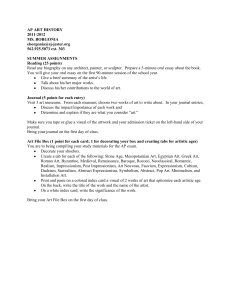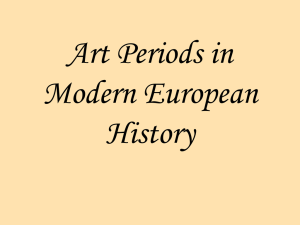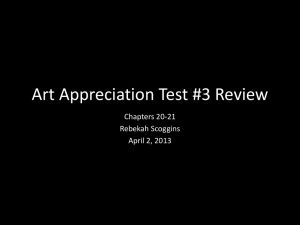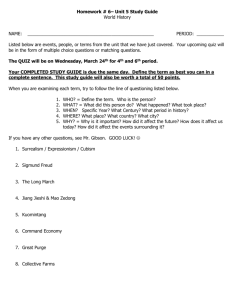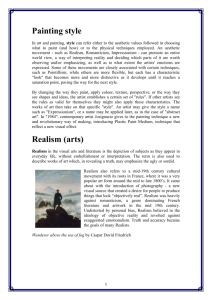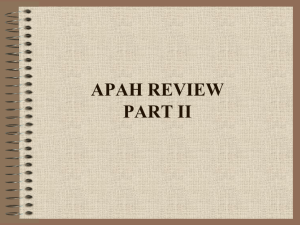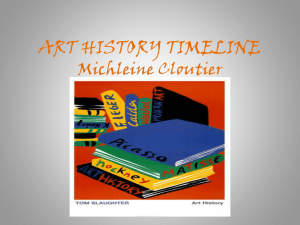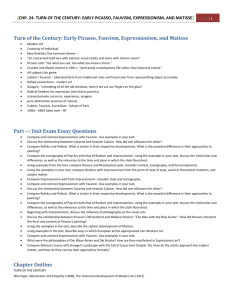Study Guide for Test #3
advertisement
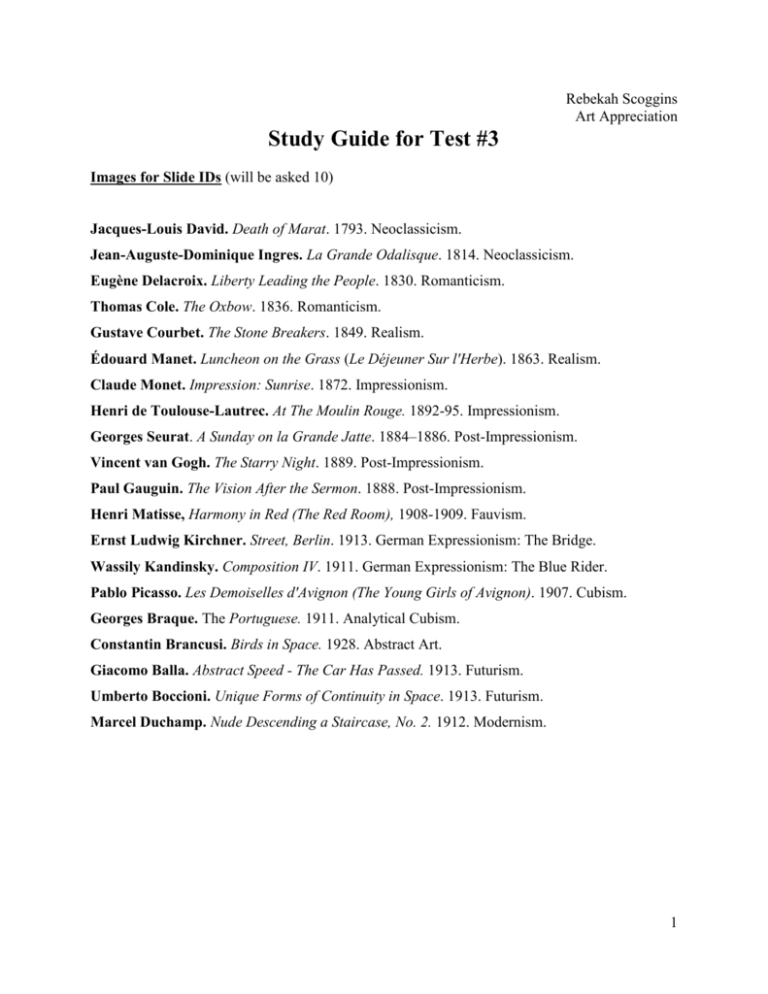
Rebekah Scoggins Art Appreciation Study Guide for Test #3 Images for Slide IDs (will be asked 10) Jacques-Louis David. Death of Marat. 1793. Neoclassicism. Jean-Auguste-Dominique Ingres. La Grande Odalisque. 1814. Neoclassicism. Eugène Delacroix. Liberty Leading the People. 1830. Romanticism. Thomas Cole. The Oxbow. 1836. Romanticism. Gustave Courbet. The Stone Breakers. 1849. Realism. Édouard Manet. Luncheon on the Grass (Le Déjeuner Sur l'Herbe). 1863. Realism. Claude Monet. Impression: Sunrise. 1872. Impressionism. Henri de Toulouse-Lautrec. At The Moulin Rouge. 1892-95. Impressionism. Georges Seurat. A Sunday on la Grande Jatte. 1884–1886. Post-Impressionism. Vincent van Gogh. The Starry Night. 1889. Post-Impressionism. Paul Gauguin. The Vision After the Sermon. 1888. Post-Impressionism. Henri Matisse, Harmony in Red (The Red Room), 1908-1909. Fauvism. Ernst Ludwig Kirchner. Street, Berlin. 1913. German Expressionism: The Bridge. Wassily Kandinsky. Composition IV. 1911. German Expressionism: The Blue Rider. Pablo Picasso. Les Demoiselles d'Avignon (The Young Girls of Avignon). 1907. Cubism. Georges Braque. The Portuguese. 1911. Analytical Cubism. Constantin Brancusi. Birds in Space. 1928. Abstract Art. Giacomo Balla. Abstract Speed - The Car Has Passed. 1913. Futurism. Umberto Boccioni. Unique Forms of Continuity in Space. 1913. Futurism. Marcel Duchamp. Nude Descending a Staircase, No. 2. 1912. Modernism. 1 Terms to Know and Understand (be able to define /or explain the significance of these terms) Industrial Revolution French Revolution Neoclassicism Romanticism Painterly Academic art Salon Realism Impressionism Post Impressionism Pointillism Japonaiserie Avant-garde Fauvism German Expressionism o Die Brücke (The Bridge) o Der Blaue Reiter (The Blue Rider) “Inner Necessity” Cubism o Analytical Cubism o Synthetic Cubism Papier Collé/Collage “prairie houses” o Open Plan Armory Show Manifesto Futurism General Concepts to Study 1. Know the differences between and the major aims/characteristics of the –isms and know the major artists of the eras: Neoclassicism, Romanticism, Realism, Impressionism, Post Impressionism, Fauvism, German Expressionism: The Bridge, German Expressionism: The Blue Rider, Cubism, Abstract Sculpture, American Modernism, Futurism 2. Know the four major factors that led to Neoclassicism and what those factors entailed/meant 3. Understand the major artistic influences on the movements, such as Ancient Roman and Greek thought on Neoclassicism, Manet’s influence on the Impressionists, Japanese 2 woodblock prints’ influence over Impressionism and Post Impressionism, van Gogh and Gauguin’s influence on the Fauvists and German Expressionists (both), Cezanne’s influence on Cubism, Non-Western art and ancient art on Cubism, Fauvism, and Abstract Sculpture, Cubism’s influence over Futurists and American Modernists 4. Understand how the artists of Post Impressionism, Fauvism, German Expressionism (both), Cubism, and Futurists used and manipulated color and why that was important 5. Examine the innovations in technique that developed from Impressionism to Futurism, such as the change in approaches to brushwork, composition, naturalism, figures, background/foreground relationships, color, line, shape, etc. 6. Be prepared to make comparisons between art from different movements using formal elements such as line, color, light, subject matter, technique, brushstroke, etc. 7. Understand the personal motivations of artists, such as the political influence on David, the social cause of Romanticists, the societal influence on the Impressionist, the personal motivations of van Gogh and Gauguin, the spiritual influence on Kandinsky, etc . 8. Explain the shift in subject matter between movements in the modern age that caused distress for critics and artists alike, such as the shift to realistic subjects (many of lower class citizens) in Realism, images of modern life in Manet and Impressionism, move toward abstract subjects by Kandinsky and Cubism, etc 9. Know the artist responsible for the complete break with subject matter/move to complete abstraction 10. Know the importance of outside institutions on art, such as the Academies, the Salon, and the Armory Show. 3
